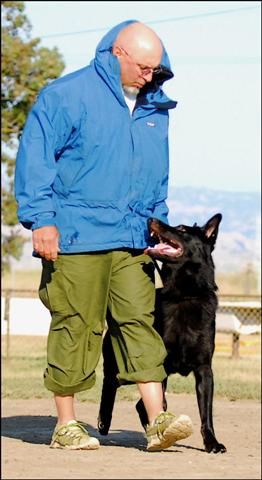www.Germanshepherdk-9.com
Home of
Larry - Curly - Moe
German Shepherd working dogs!
Larry - Curly - Moe
German Shepherd working dogs!
What is Compulsion Dog Training?
Punishment, Control, Force and Pressure training

Focus Training
For this application, collar corrections are used to discipline the dog. A correction helps the dog understand the commanded exercise (focus) is not optional and must be obeyed. This is used for a dog that has had previous focus training through positive reinforcement and demonstrates the ability to reliably focus on the handler; but, sometimes becomes distracted and requires a simple reminder to stay focused on the work. Corrections are done based on the dog's tolerance level. *As a side note: from our experience, nagging corrections typically are not effective enough in the long run.
Controlling the dog's Drive
Compulsion training is an effective tool if used appropriately for control of the dog. Most dogs with pronounced working drives require some compulsion, in the form of collar corrections, (adjusted according to the dog's tolerance level) for control while training through high-stimulation situations.
As an example, the protection phase of the Schutzhund sport is an exercise that causes the dog to become highly stimulated; but, at the same time, the dog must still remain controlled. While working through high-stimulation exercises, a dog's ability to control working drives is developed through training by the handler, this is called conditioning. Simple drive control exercises are taught to the dog from the start. The dog is given a command to perform a basic task that has been demonstrated previously during a lower-stimulation training scenario; such as, the "sit", "down", and "heel", etc. The dog is then given an opportunity to perform the command. However, chances are great, the dog will show resistance to obedience. A simple exercise will be difficult for the dog to complete; because, the desire to interact with the high-stimulus is of greater value to the dog than the need to exhibit obedience and control.
The dog must learn that he will be released to interact with the stimulus; i.e. "helper" by showing obedience and control. When and if a command is not obeyed, obedience and control through leash corrections, adjusted according to the dog's pain tolerance level, are applied. Once obedience and control is demonstrated, the dog is rewarded through a release. The dog is given the freedom, from the handler, to engage the helper. Through this process, the dog learns that the incentive to engage the helper is earned by obeying the handler and showing control.
Force Training
There is another component to compulsion that we call force training. This is when a dog is forced to work through continuous pinch collar or e-collar corrections. Basically the dog learns how to escape uncomfortable corrections through trial and error. A command is given, then a non-stop correction is applied, until the task is completed. Eventually the dog learns which behaviors to offer in order to stop the collar corrections. The dog will complete the exercise on command, because an uncomfortable pattern has been imprinted.
Studies have shown that "real working dogs" (not specific to precision sport; i.e., IPO, Schutzhund) do not require force training to be motivated and have a stronger work ethic without it. They tend to be more productive and show higher success rates when allowed to work freely. Even so, Force Training will remain necessary and a common practice in the K-9 sport world, as long as, the method helps k-9 teams reach desired scores.
Ref: Canine Ergonomics: The Science of Working Dogs by William S. Helton
Pressure Training
There is an enormous amount of pressure on trial day, especially off the club field and at the competition level. In the Schutzhund dog sport we need to know that the dog can work through various types of stress. There are a variety of ways to make this determination, however compulsion is often the method of choice.
There is a belief that compulsion enables a handler to determine a dog's level of stress tolerance, often being used as another training component in an attempt to evaluate a dog's working temperament. Compulsion training can certainly give us an idea of a dog's pain tolerance level and if in fact a particular dog will function better under a light handed or heavy handed trainer. What compulsion does not indicate, is how a dog truly works under stressful conditions and situations. For this determination the dog simply needs to be evaluated while work in various environmental situations.
German Shepherd k9 Copyright 2021





